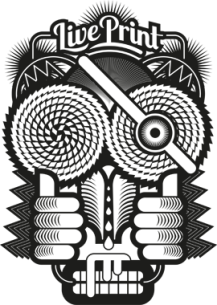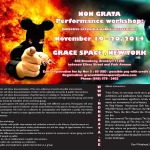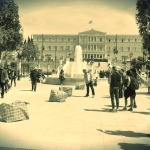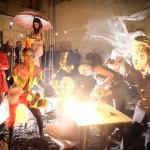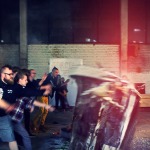
Non Grata: Performing Like a Child of the Storm Generation
Published in Incident Magazine
Watching Non Grata perform and performing as Non Grata are two completely different experiences, a difference that can be best described as watching a tornado carve out its path from a distance, and being thrashed around in the eye of the cyclone: what looks like organized chaos, is just, well, chaos.
Non Grata, which is filled with a rotating group of artists of many backgrounds from around the world, gains a sort of reputation, a persona given by the crowd before you take center stage. You gain the reputation of being wild and dangerous, you put on that mask, and you always feel like you live up to the crowd’s expectations. At times you want to get lost in the moment of performing in a smoke hazed room, you become focused and nearsighted in vision, an hour can go by in a minute—this while also having to always look over your shoulder in case you run into another performer or an errant flame. After the adrenaline wears off and the spectacle recedes, the debris from the performance fills up the once clean gallery space. “Was that a good performance?,” you ask yourself. “What were the other performers doing? What happened?” Well, these things happen.
Non Grata is back in the United States after an extended tour that included Athens, Latvia, Beijing, and South Korea; the collective will be holding at month long stay in November at Grace Exhibition Space that will include curated shows, as well as a performance workshop on the 19th and 20th that explores how to perform like a child of the Storm Generation.
Al Paldrok, a founding member of Non Grata, answered a few questions through email about the workshop, as well as some his ideas, methods and experiences in teaching performance and public interventions.
– David LaGaccia
Interviewer
For the workshop, how have you designed the workshop based on your previous experiences in performance and public intervention?
Paldrok
My performance workshops are designed like the Academia Non Grata curriculum and educational philosophy – it is based on the method to trigger a creative explosion in people and help them find their own individual expression suitable to their own mental and physical capacity. To release the wild side and connect into the intellectual and social context.
During the workshop, participants can bring their ideas strait to the society and express themselves how they want – politically, socially, existentially. If you have something important to say – Do it, just do it. Workshop participants will help each other to make it happen – in street context there is lot of details what you have to take care off – starting from just keeping you personal belongings safe during the action, to blocking police and security when you escape.
This summer we made workshop in Athens what ended up with political protest actions in front of the Greece parliament and there this practice was in use in full script.
Conception, Chile with local participants we cached the president of the country with his crowd on the street and used them in performance, creating situation where the border between art and life disappeared.
Interviewer
What have you felt works, or doesn’t work on understanding and making performance?
Paldrok
There are no bad performance ideas, but there are thousands of lousy ways of realizing them. First of all you have to have guts and when you know the truth, you have to spread it around, loud and wide. In workshop you can make things what you never are able to make alone.
Interviewer
Were the designed activities informed from personal methods that you have found beneficial for making good performance, or are you exploring new methods in the creation of performances and public interventions?
Paldrok
An artist’s own body can be a performance instrument, however, today its importance gradually decreases – there are robots, electronic and mechanical devices, automobiles, crowds of people – that all can be remotely directed. One’s own body is definitely the most available means. One can direct a performance totally separate from one’s body, using only one’s brain. To create a non-carnal space, a virtual performance or global catastrophe where performative activities start functioning on their own, disconnected from body. A brain is still a material part of one’s body, a thought originating from there is already a compromise between an idea and materialized reality. The real world is, as we all know, imperfect. Within the compromise between the spiritual and real, the carnal side finally determines, as it acts as a filter or stirrer of the channelized idea. Filters and stirrers are widely used in all kinds of technical activities precisely as the factors that distort the original signals and raise the quality. Carnal filter in co-operation with the surrounding real absurd theatre at its best will result is a creation of a reality shift which, in turn, will bring about a new mental dimension that will, on the meta-level, initiate new processes. Therefore, the initial idea being thrown into the mundane reality is rather in a secondary role, it is more of a trigger.
Interviewer
Can you “teach” someone how to make performance? or is it a manner of learning by doing?
Paldrok
First of all – what is performance? Art is a deeply personal tool and really what teachers can do is give practical advises based on earlier experiences and encourage participants to contribute fully and not to be afraid of anything.
Interviewer
You have done many performance and interventions in the street and in a crowd. Does the space where you teach your methods affect the quality how performers learn new methods? What are the benefits of learning to perform inside a gallery, and what are the benefits of learning to perform outside on the street? Does each space have new things to learn from?
Paldrok
A vast majority of performances are interactive and in whatever crazy situations one can expect anything: from verbal disturbances to direct physical attack by the audience, unexpected spatial configurations, interference by the police, fire brigade, ambulance etc. One of the most important characteristic features of a performance artist is the ability to control the performative process. To be ready to improvise and guide the processes in an unexpected situations.
Gallery performances are safe versions, at least in western world everything is allowed there.
I use the performance medium, because it is very hard to say what it is exactly. This is what I like most about it and also it’s what makes it interesting for people, unexpected results, you never know what you are going to get, you see something, but you do not know what it is (It is the opposite of entertainment – there, you get what you expect). When you know it is politics, you turn away, it’s boring, when it is protest action, theatre, circus, protest to save nature, gender, animals, humanity, it’s the same thing. In a museum context everybody knows that you get performance art there – booooring! It takes all the layers away from the act and leaves just one – contemporary art. For that reason I like it when in performance art circles they say, that Non Grata is not real Performance Art.
I think it is really important to take back public place as platform of changing society.
It is not fighting against the system but approving of the system. We are all living in this structure and our goal is to make it a better place. The world is now so big, so complicated a structure that it is beyond our human understanding. I truly believe that all these cursed politicians and people in financial positions – they are not evil in their hearts, I think they make the best with what their human resources allow. Unfortunately their intellectual capacity is just not enough. So creative forces have to take over this system, if they want to approve it. If we do not do it, then there is no point for us to whine.
